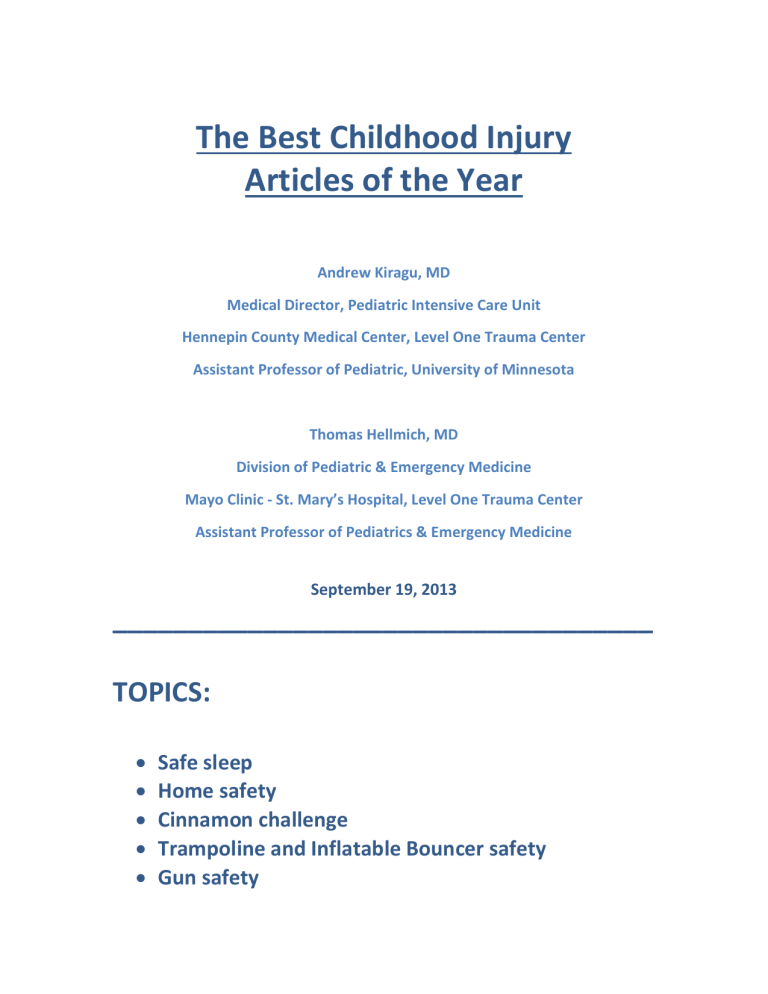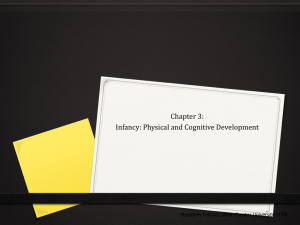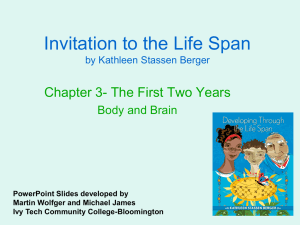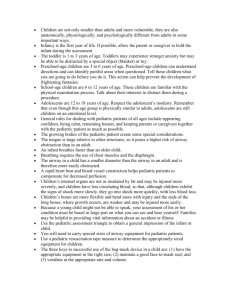The Best Childhood Injury - Minnesota Safety Council

The Best Childhood Injury
Articles of the Year
Andrew Kiragu, MD
Medical Director, Pediatric Intensive Care Unit
Hennepin County Medical Center, Level One Trauma Center
Assistant Professor of Pediatric, University of Minnesota
Thomas Hellmich, MD
Division of Pediatric & Emergency Medicine
Mayo Clinic - St. Mary’s Hospital, Level One Trauma Center
Assistant Professor of Pediatrics & Emergency Medicine
September 19, 2013
____________________________________
TOPICS:
Safe sleep
Home safety
Cinnamon challenge
Trampoline and Inflatable Bouncer safety
Gun safety
Journal of Pediatrics
. 2012 Jan;160(1):44-8.e2. doi: 10.1016
Bed sharing and the risk of sudden infant death syndrome: can we resolve the debate?
Vennemann MM, Hense HW, Bajanowski T, Blair PS, Complojer C, Moon RY, Kiechl-
Kohlendorfer U.
SourceInstitute of Legal Medicine, University of Münster, Münster, Germany.
Abstract
OBJECTIVE: To conduct a meta-analysis on the relationship between bed sharing and sudden infant death syndrome (SIDS) risk.
STUDY DESIGN: Data from PubMed and Medline were searched for studies published after Jan 1, 1970. The search strategy included articles with the terms
"sudden infant death syndrome," "sudden unexpected death," and "cot death" with
"bed sharing" or "co-sleeping." To further specify the potential risk of bed sharing and SIDS, subgroup analyses were performed.
RESULTS: Eleven studies met inclusion criteria and were included in the final metaanalysis. The combined OR for SIDS in all bed sharing versus non-bed sharing infants was 2.89 (95% CI, 1.99-4.18). The risk was highest for infants of smoking mothers (OR, 6.27; 95% CI, 3.94-9.99), and infants <12 weeks old (OR, 10.37; 95%
CI, 4.44-24.21).
CONCLUSIONS: Bed sharing is a risk factor for SIDS and is especially enhanced in smoking parents and in very young infants
Social Science Medicine
. 2013 Feb;79:92-100.
Nighttime parenting strategies and sleep-related risks to infants
Volpe LE, Ball HL, McKenna JJ.
SourceDepartment of Anthropology, Parent-Infant Sleep Lab, Durham University,
UK. l.e.volpe@durham.ac.uk
Abstract
A large social science and public health literature addresses infant sleep safety, with implications for infant mortality in the context of accidental deaths and Sudden
Infant Death Syndrome (SIDS). As part of risk reduction campaigns in the USA, parents are encouraged to place infants supine and to alter infant bedding and elements of the sleep environment, and are discouraged from allowing infants to sleep unsupervised, from bed-sharing either at all or under specific circumstances, or from sofa-sharing. These recommendations are based on findings from largescale epidemiological studies that generate odds ratios or relative risk statistics for various practices; however, detailed behavioural data on nighttime parenting and infant sleep environments are limited. To address this issue, this paper presents and discusses the implications of four case studies based on overnight observations conducted with first-time mothers and their four-month old infants. These case studies were collected at the Mother-Baby Behavioral Sleep Lab at the University of
Notre Dame USA between September 2002 and June 2004. Each case study provides a detailed description based on video analysis of sleep-related risks observed while mother-infant dyads spent the night in a sleep lab. The case studies provide examples of mothers engaged in the strategic management of nighttime parenting for whom sleep-related risks to infants arose as a result of these strategies. Although risk reduction guidelines focus on eliminating potentially risky infant sleep practices as if the probability of death from each were equal, the majority of instances in which these occur are unlikely to result in infant mortality. Therefore, we hypothesise that mothers assess potential costs and benefits within margins of risk which are not acknowledged by risk-reduction campaigns. Exploring why mothers might choose to manage sleep and nighttime parenting in ways that appear to increase potential risks to infants may help illuminate how risks occur for individual infants.
Pediatrics
. 2012 Dec; 130(6):1053-9.
Home safety and low-income urban housing quality
Gielen AC, Shields W, McDonald E, Frattaroli S, Bishai D, Ma X.
SourceJohns Hopkins Center for Injury Research and Policy, Baltimore, MD 21205,
USA. agielen@jhsph.edu
Abstract
OBJECTIVES: Living in substandard housing may be one factor that increases the risk of fire and burn injuries in low-income urban environments. The purposes of this study are to (1) describe the frequency and characteristics of substandard housing in urban homes with young children and (2) explore the hypothesis that better housing quality is associated with a greater likelihood of having working smoke alarms and safe hot water temperatures.
METHODS: A total 246 caregivers of children ages 0 to 7 years were recruited from a pediatric emergency department and a well-child clinic. In-home observations were completed by using 46 items from the Housing and Urban Development's
Housing Quality Standards.
RESULTS: Virtually all homes (99%) failed the housing quality measure. Items with the highest failure rates were those related to heating and cooling; walls, ceilings, and floors; and sanitation and safety domains. One working smoke alarm was observed in 82% of the homes, 42% had 1 on every level, and 62% had safe hot water temperatures. For every increase of 1 item in the number of housing quality items passed, the odds of having any working smoke alarm increased by 10%, the odds of having 1 on every level by 18%, and the odds of having safe hot water temperatures by 8%.
CONCLUSIONS: Many children may be at heightened risk for fire and scald burns by virtue of their home environment. Stronger collaboration between housing, health care, and injury prevention professionals is urgently needed to maximize opportunities to improve home safety
Pediatrics
Vol. 131 No. 5 May 1, 2013, pp. 833 -835.
Ingesting and Aspirating Dry Cinnamon by Children and
Adolescents: The “Cinnamon Challenge”
Amelia Grant-Alfieria,b, Judy Schaechter, MD, MBAc,d,e, and Steven E. Lipshultz,
MDa,b,d,e,f
+ Author Affiliations aDivision of Pediatric Clinical Research, bProgram in Pediatric Integrative Medicine, cDivision of Adolescent Medicine, dDepartment of Pediatrics, University of Miami Leonard M. Miller School of Medicine, Miami, Florida; eHoltz Children’s Hospital of the Jackson Health System, Miami, Florida; and fBatchelor Children’s Research Institute, Miami, Florida
Key Words:cinnamonparticulate inhalationpediatricsrespiratory effects
Pediatrics Perspective
The “Cinnamon Challenge” entails swallowing a tablespoon of ground cinnamon in
60 seconds without drinking fluids. However, as stated on www.cinnamonchallenge.com, this challenge is practically impossible, decidedly unpleasant, and potentially harmful. The site warns: “Do not attempt the cinnamon challenge without talking to a doctor. Obviously they [sic] are going to tell you not to do it. [It] can be dangerous and shouldn’t be taken lightly. You never want to purposely or mistakenly inhale any substances such as cinnamon. It’s going to burn, you are going to cough, and regret you tried.”1
Videos of people attempting the Cinnamon Challenge have become an Internet sensation. Typically, a video reveals a group of adolescents watching as someone taking the challenge begins coughing and choking when the spice triggers a severe gag reflex in response to a caustic sensation in the mouth and throat. As of August
10, 2012, there were 51 100 YouTube clips depicting the Cinnamon Challenge. One video was viewed >19 million times, predominantly by 13- to 24-year-olds, ages similar to people taking the Cinnamon Challenge and associated with the greatest need for conformity.
These videos have raised concerns of choking, aspiration, and pulmonary damage.
In most cases, the effects are temporary, yet the Cinnamon Challenge has led to dozens of calls to poison centers, emergency department visits, and even hospitalizations for adolescents requiring ventilator support for collapsed lungs.
Pediatrics.
2012 Dec; 130(6):1076-83.
Pediatric inflatable bouncer-related injuries in the United States,
1990-2010.
Thompson MC, Chounthirath T, Xiang H, Smith GA.
SourceCenter for Injury Research and Policy, The Research Institute at Nationwide
Children’s Hospital, Columbus, OH 43205, USA.
Abstract
OBJECTIVE: To investigate inflatable bouncer-related injuries to children in the
United States.
METHODS: Records were analyzed from the National Electronic Injury Surveillance
System for patients ≤17 years old treated in US emergency departments (EDs) for inflatable bouncer-related injuries from 1990 to 2010.
RESULTS: An estimated 64 657 (95% confidence interval [CI]: 32 420-96 893) children ≤17 years of age with inflatable bouncer-related injuries were treated in US
EDs from 1990 to 2010. From 1995 to 2010, there was a statistically significant 15fold increase in the number and rate of these injuries, with an average annual rate of
5.28 injuries per 100 000 US children (95% CI: 2.62-7.95). The increase was more rapid during recent years, with the annual injury number and rate more than doubling between 2008 and 2010. In 2010, a total of 31 children per day were treated in US EDs for an inflatable bouncer-related injury, which equals a child every
46 minutes nationally. A majority of patients were male (54.6%), and the mean patient age was 7.50 years (95% CI: 7.17-7.83). Most injuries were fractures
(27.5%) and strains or sprains (27.3%), and most injuries occurred to the lower
(32.9%) or upper (29.7%) extremities. Most injuries occurred at a place of sports or recreation (43.7%) or at home (37.5%), and 3.4% of injured children were hospitalized or kept for <24 hours for observation.
CONCLUSIONS: The number and rate of pediatric inflatable bouncer-related injuries have increased rapidly in recent years. This increase, along with similarities to trampoline-related injuries, underscores the need for guidelines for safer bouncer usage and improvements in bouncer design to prevent these injuries among children
Pediatrics
. 2012 Oct; 130(4):774-9.
Trampoline safety in childhood and adolescence.
Council on Sports Medicine and Fitness
, American Academy of Pediatrics, Briskin
S, LaBotz M.
Collaborators (19)Brenner JS, Benjamin HJ, Cappetta CT, Demorest RA, Halstead ME,
Koutures CG, LaBella CR, LaBotz M, Loud KJ, Martin SS, Kelly AK, McCambridge TM,
Gregory AJ, Philpott JF, Klutchurosky LK, Walter KD, Stricker P, Drew GR, Emanuel A.
Abstract
Despite previous recommendations from the American Academy of Pediatrics discouraging home use of trampolines, recreational use of trampolines in the home setting continues to be a popular activity among children and adolescents. This policy statement is an update to previous statements, reflecting the current literature on prevalence, patterns, and mechanisms of trampoline-related injuries.
Most trampoline injuries occur with multiple simultaneous users on the mat.
Cervical spine injuries often occur with falls off the trampoline or with attempts at somersaults or flips. Studies on the efficacy of trampoline safety measures are reviewed, and although there is a paucity of data, current implementation of safety measures have not appeared to mitigate risk substantially. Therefore, the home use of trampolines is strongly discouraged. The role of trampoline as a competitive sport and in structured training settings is reviewed, and recommendations for enhancing safety in these environments are made.






